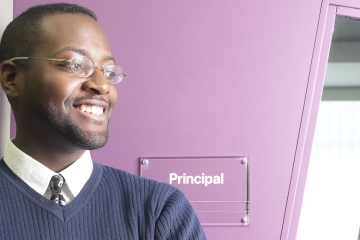Centering the work of charter schooling and authorizing in communities means listening to the aspirations and needs they have for students—especially communities that have been overlooked and not prioritized, like communities of color, those from lower-income tax brackets, and those with disabilities—and delivering with, not to, them.
Working with communities is not just the right thing to do. It works to produce better, more sustainable results for students and communities. I have experienced it first-hand as a charter school authorizer in Indianapolis.
One of the most successful schools that my team authorized was The Excel Center, which opened in Indianapolis in 2010 in partnership with Goodwill Industries to meet the need of overage, under-credited students who often were trying to get their high school degree for a second or third time. The genesis for the idea came from conversations the Indianapolis charter authorizing team had held with members of the community, listening to their concerns that current educational options relied too heavily on the GED as the only means for adult students to finish high school. That conversation ultimately led to today’s growing network that now comprises fifteen Excel Center locations throughout Indiana, and more in Arkansas, Missouri, Tennessee, Texas, and D.C.
A second example of successfully authorizing a school that came from the community is the Tindley Accelerated School. Since its founding in 2004 and expansion over the years, the school has been among the highest-performing networks of schools in Indianapolis, focusing on getting students into and through four-year colleges and universities. Tindley wasn’t conceived out of the blue. It was the first step of a community-initiated effort to revitalize a neighborhood, which included residents, local educators, civic organizations, city officials, and philanthropists. That work, aided largely by the quality of Tindley’s middle and high schools, has attracted reinvestment in the community.
In a recent Fordham Institute essay, Chester E. Finn, Jr. described the complicated realities of working with communities and offered a welcome push on several organizations, including the National Association of Charter School Authorizers, where I am president and CEO. I’m thankful for people like Finn, who are willing to highlight the potential unintended consequences of engaging communities in school improvement, and especially the risks of doing it poorly. It’s a mistake to miss important learnings from past efforts or tune out people who ask tough questions.
I walked away from his piece, not with second thoughts about centering communities, but with an enhanced commitment to doing it wisely, with a deep level of humility, and with the knowledge that figuring it out together will be complicated.
Make no mistake, working with communities does mean upending traditional power arrangements and shifting power to those who live there. But it doesn’t mean shifting power to structures, entities, and people who have failed communities and students—especially Black students who look like me—for generations. The loudest voices in the room do not always speak on behalf of kids and communities. Families, students, and neighborhoods must be able to voice what their kids aspire to, and have the power to make it so.
Competing interests in communities are real; no community is monolithic. Who decides whose voice is heard is a big challenge. Creating new power structures that also fail kids and communities is a real threat. Anyone who tells you that they have easy answers to these complicated, value-laden questions isn’t being candid. Those of us in positions to help deliver on community aspirations and needs must start from a place of humility. We might have critical policy expertise, but we also don’t know the exact right path and need to start by listening more. That also means perpetually asking questions of a lot of people in communities, prioritizing the voices of often unheard people there, and muddling our way to workable, albeit imperfect, solutions together that ultimately lead to better life outcomes for students.
In too many political and policy debates, the tendency is to go black or white, leaning on pendulum swings. We either are in school every day or doing fully remote learning during Covid-19. We either focus on reading and writing or pursue racial justice. We either listen and act on community aspirations or we have excellence. But pursuing either-or thinking is damaging and unhelpful. While we can never compromise our values—and excellent schools are among our values—finding the both-and is usually the best, if hard-to-implement and hard-to-sustain, solution. That’s where the intricacies of implementation exist, and frankly, where policy wonks, like Finn, myself, and others, can listen to communities, roll up our sleeves, create new kinds of coalitions, and figure out the right policy levers that speak to common values and get the results we all want for kids.
Among the most challenging areas, where competing interests and power dynamics are the most visible in charter schooling and authorizing, is the idea of closing a school. Closing a failing school is extremely important to ensure students, current and future, do not get stuck in low-performing schools that do not educate them. But it’s not an easy nor simple process, especially when working with communities who may value and support schools that others would deem a failure.
I remember one instance as an authorizer where I had to lead the closing of a school. Many families were well served by that school, and those families wanted it to stay open with some modifications. But there were far more families who weren’t well served, many of whom had already left for other options, whom we also listened to. Add in that the owner of the school’s facility was a relatively small, local community organization that needed the revenue from the facility, but also wanted residents to be well served academically. Competing interests indeed.
We did the right thing by announcing the closure of the school nearly a year and a half before its contracted end date, so that families could find a better alternative far in advance of the school closing. But if I could go back, we could have done more with the community. For instance, we should have focused more intently on a replacement strategy earlier—that is, finding a new and better operator in the area that could build a better school based on the community’s aspirations for their children. We could have listened better to parents and students to find ways of maintaining the good things from the closing school to continue forward with a new operator; or ensure the facility could be used for community advancement, if not a school; or advocate more forcefully for policy changes so that students from closing schools would have admissions preference to other schools of their choice. (Fortunately, this exists today, but didn’t at the time.)
When charter school authorizers—and anyone in education—see themselves, not as distant authorities who don’t want to get involved with communities (which NACSA sometimes sees among authorizers who claim getting involved “isn’t their job”), but as people who can work with communities to make their aspirations a reality, we have an opportunity to create outstanding options for kids and to ensure that we are delivering with, not to, communities. Will this be complicated, as Finn cautions? Yes. Must we learn from successes and mistakes in our past? Yes. But that cannot replace the moral imperative of working to deliver on the smart ideas and with the talented people in communities across the country. Sign me up for the challenge and complexity if it means we can have community- and life-changing options like Tindley and the Excel Centers.







